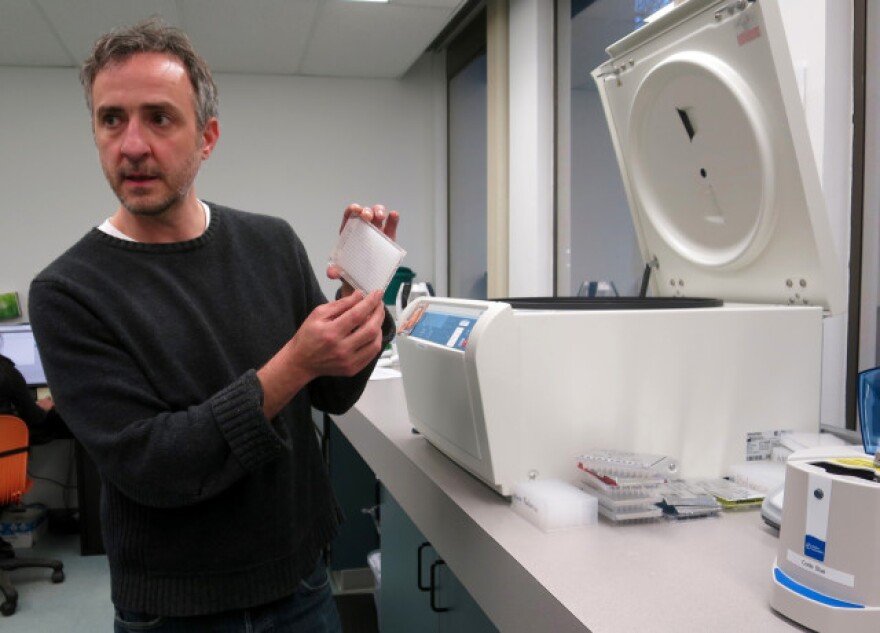Imagine youŌĆÖre starting your own marijuana farm.
First you get land and water rights. Then youŌĆÖve got to find the right strain of cannabis. That can involve as much luck as science.
ŌĆ£ThereŌĆÖs a lot of legend and laws,ŌĆØ said Mowgli Holmes, the chief scientific officer at Phylos Bioscience.
ŌĆ£In general itŌĆÖs like, ŌĆśMy friend Billy gave me this. And he told me that he got it from this guy. And ŌĆ” this is the original thing. This is the lost cut of Panama Red from so and so in 1978.ŌĆÖŌĆØ
Phylos Bioscience is an Oregon startup that, for a few hundred dollars, will outline the genetic profile of any cannabis plant you bring them.
The information is great for growers ŌĆö it helps farmers ensure theyŌĆÖre not going to get sued for infringing on someone elseŌĆÖs intellectual property.
Growers need that kind of detail, because the cannabis market is a mess. Holmes said medical consumers, for example, canŌĆÖt be assured the strain they buy one week will be the same next week.
ŌĆ£They find something and itŌĆÖs called ŌĆśLemon HazeŌĆÖ or whatever. But then they canŌĆÖt get it again. They go back and they get something called the same thing, but itŌĆÖs not the same thing,ŌĆØ he said. ŌĆ£And they canŌĆÖt get the same thing anywhere else even though it has the same name because people just rename things, because they donŌĆÖt know what they are.ŌĆØ
Phylos is only one of dozens of Oregon startups doing research on marijuana.
ŌĆ£The numbers we just received by phone says in the last six months thereŌĆÖs $60 million to $80 million that has gone into startups,ŌĆØ said State Sen. Floyd Prozanski, D-Eugene, who sits on OregonŌĆÖs medical regulation committee.
There are all kinds of different businesses. Some are trying to perfect the process of extracting cannabis oil. Some are developing a dermal patch ŌĆö so people can absorb marijuana through their skin. This January, a group of entrepreneurs launched the ŌĆ£Oregon Hub,ŌĆØ a farm and research center in Clackamas County that aims to improve growing techniques by finding ways, for example, to reduce water and energy use.
Seth Crawford and his brother run ŌĆ£Oregon CBDŌĆØ in the Willamette Valley. TheyŌĆÖre working with industrial hemp, which is federally legal as long as it contains less than 0.3 percent of the active cannabis ingredient, THC.
Their goal is to invigorate AmericaŌĆÖs old industrial hemp market by breeding plants to grow in a variety of climates.
ŌĆ£YouŌĆÖre looking at humidity, mold and mildew resistance, a number of different types of potential pathogens that emerge in specific micro-climates that we try to adapt our plants for,ŌĆØ he said.
So there is plenty of marijuana research going on in Oregon. But itŌĆÖs startup research ŌĆö not the kind of peer-reviewed, double-blind research thatŌĆÖs going to lead to FDA-approved medications. Thus, the benefits for patients are less direct.
Most FDA-level marijuana science is being conducted overseas. A British company recently developed a cannabis extract called Sativex. ItŌĆÖs been approved for to help with neuropathic pain in 28 countries ŌĆö but not the U.S.
The FDA has also approved another drug called Marinol to treat nausea in cancer patients. ItŌĆÖs made out of synthetic THC, the compound in marijuana that gets you high.
But marijuana contains a hundred compounds or more, and experts say itŌĆÖs the interaction between those compounds that give the plant its medical properties.
The FDAŌĆÖs drug approval process doesnŌĆÖt deal with so many compounds at one time.
So perhaps the future of OregonŌĆÖs medical marijuana market will be in the form of supplements and ŌĆ£whole plantŌĆØ edibles, rather than new FDA-approved medications.
Copyright 2017 Oregon Public Broadcasting



